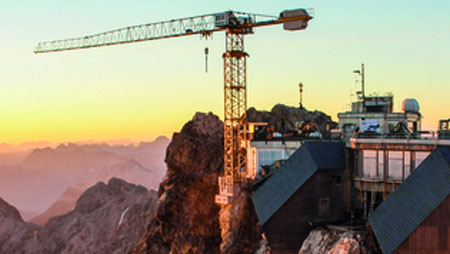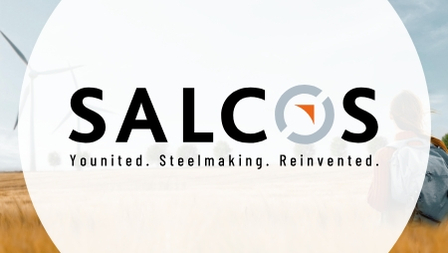Yellow Goods
06.07.2016 | Salzgitter Flachstahl GmbH
Yellow Goods
Cranes, excavators, and bulldozers are indestructible helpers in bridge, road, and house construction. They are made predominantly of steel, because steel is the only material that can stand up to the challenges in this sector.
Bottom and top-slewing

Liebherr is one of the world’s leading manufacturers of cranes and other construction machinery, and Salzgitter AG also supplies the company.
There is a certain symbolism in the fact that a crane from Liebherr is found at what is currently Germany's highest construction site: after all, the Liebherr group of companies is one of the world's leading construction machinery manufacturers. This so-called tower crane is helping to build the new Eibsee cable car which will start transporting visitors to the Zugspitze, Germany's highest mountain, in 2018. Because extreme weather conditions sometimes prevail at the almost 3,000 m altitude, extremely demanding requirements were placed on the steel structure and anchor for the tower crane: requirements that only a few of the world's companies can fulfill.
The construction of tower cranes (TC) more than six decades ago marked the start of the Liebherr industrial enterprise. TCs are the classics among the cranes and are still the standard for the construction of private homes, industrial buildings, and high-rises today. The sizes vary greatly: While the smallest crane can lift just 500 kg at the tip of the 22-meter jib, the biggest one handles a colossal 42 metric tons with a jib that is almost 100 m long. Liebherr cranes are designed as modular systems and can be configured in almost 1,000 different variations in order to meet the customer's specific requirements.
The tower cranes are predominantly built at Liebherr-Werk Biberach GmbH, which employs some 1,300 people. Between 15,000 and 20,000 metric tons of steel are required each year to produce around 1,000 cranes. Salzgitter AG has been supplying Liebherr for more than 60 years. Managing director Günther Hardock: "We buy sheets that are up to 12 mm thick and also profiles from Salzgitter. The steel is used to construct rotating platforms, driver’s cabs, and switch cabinets. We value Salzgitter AG due to their competent technical customer representatives and we view the firm as a reliable supplier who has never let us down, even in times when steel was in high demand."

The steel that is used in the towers and jibs must offer high bending strength. Reason: "The steel keeps on working even after the crane has stopped," says Wilhelm Sigg, who refers to the wind and temperature differences found at open-air construction sites. "As a rule, we use S 355." The people in Biberach are proud of the deep vertical integration. Uwe Kühn, crane technology plant manager: "For example, we largely handle the steel construction ourselves." But important crane components such as drives and switch cabinets also come from their own company: from neighboring Liebherr-Components Biberach GmbH, which employs another 1,200 people.
Tower cranes can be either bottom- or top-slewing. Bottom-slewing tower cranes consist of an undercarriage with slewing bearing on which the complete crane tower turns. The jib has a permanent connection to the crane tower. Top-slewing cranes are suitable for higher towers and loads. In this case, the crane tower is permanently mounted on an undercarriage or cruciform base and the rotating mechanism is located at the upper end of the crane tower. During rotation, only the jib and the counter-jib, which means the entire upper part of the crane, move.
Tower cranes from Liebherr have outstanding references from all over the world. Managing director Hardock: "The most recent example for the use of our cranes is the construction of the Kingdom Towers in Jeddah, Saudi Arabia. With a total height that exceeds 1,000 meters, it should be the world's highest building when it is completed in 2019.” But other illustrious names are also associated with tower cranes from Liebherr: For example, the construction of the European Central Bank (ECB) in Frankfurt, the Guggenheim Museum in Bilbao, the Allianz Arena in Munich, and the new Gazprom headquarters in St. Petersburg, which will be almost 500 meters high.
But while Liebherr cranes are sold all over the world, Austria, Germany and Switzerland continue to be important markets. Günther Hardock: Home construction is a booming business for us, and this is just the way we like it."
Strip steel from Salzgitter: the right product for every customer

Salzgitter Flachstahl GmbH produces the microalloyed S355NC and S355MC to S700MC grades for yellow goods. With the new TektoSal®400 steel, now there is additionally a product in the resistant-to-wear area. "This steel is typically used for excavator shovels, which make tougher demands on the wear resistance," explains Frank Heidelberger, SZFG marketing director. “Because many construction equipment components are created using laser cutting, we also provide two special products for these requirements. Our seca® and seca®xtra products allow us to fulfill especially tough requirements for the evenness, which is needed for the laser cutting process. The product features of seca® and seca®xtra can be very nicely combined with all the grades that we offer in our construction machinery sector, so that here we can offer the right product for almost every customer requirement."
Dr. Ralf Koch, sales director for the household appliance and end customer areas at SZFG: "We impress our customers with our quality as well as our large range of products. For example, we supply the customer Liebherr with both cold-rolled thin sheet with very demanding surface requirements for refrigerators and thick, higher strength wide strip sheets such as are needed for cranes."







